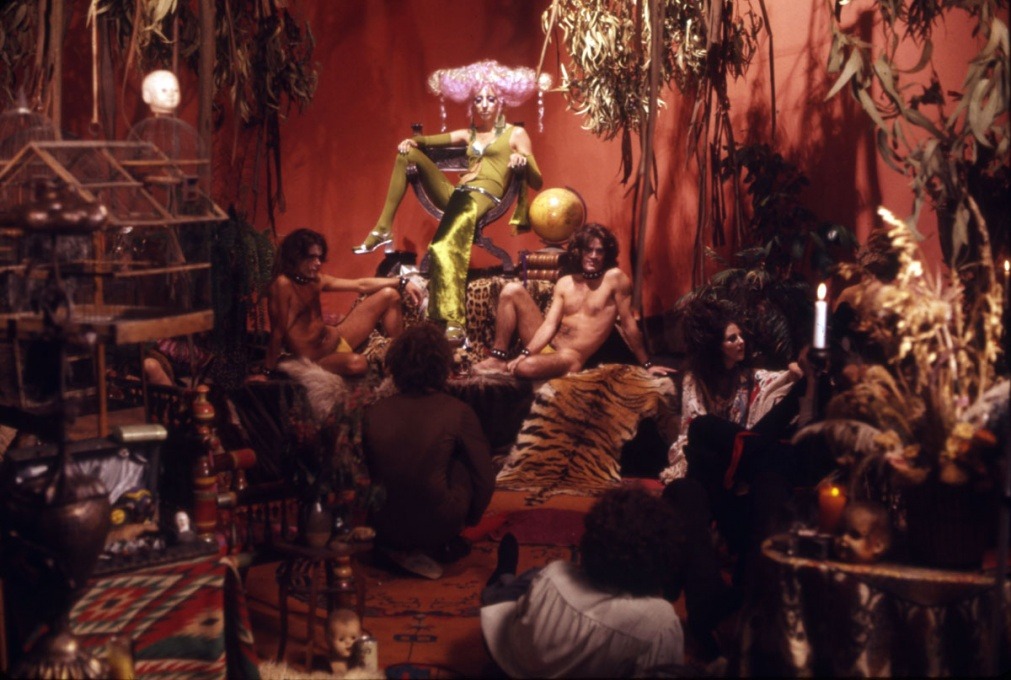The discourse around sex scenes in films and TV shows has become all but inescapable if you spend any time on Twitter. Whether it’s people up in arms about the implication of sex at the end of the trailer for She-Hulk: Attorney At Law — the latest in the endless stream of Marvel Studios productions — or the film that’s been deemed too horny for Amazon Prime, the place and purpose of sex on screen is constantly up for debate. The arguments that tend to appear on Twitter seem to be that sex on screen is unnecessary altogether, or that it should only be there if it somehow advances the plot. But this kind of oversimplification ignores the fact that stories on screen can often be about sex, bodies, and desire; from contemporary body horrors like Crimes of the Future and Titane to the resurgent erotic thriller, sex has always been in bed with the movies, whether Twitter wants to admit it or not.
And that’s where Luminous Procuress comes in. Originally released in 1971 and directed by artist Steven Arnold, the underground film — which had previously been out of circulation for years — has been restored and rereleased by Second Run. A film like Luminous Procuress, with almost zero plot, gibberish dialogue and hardcore sex scenes, would never get made today. But its return to home video shows how important the link between sex and cinema can be, and why stories about desire are worth telling.
The story follows a pair of hippies, played by Steven Solberg and Ronald Farrell, who are given a magical potion by the gender-bending Pandora, and are shown a series of erotic, intimate vignettes. Steven Arnold’s film is similar to movies like Pink Narcissus, directed by the late great James Bidgood. Both films create fantastical spaces that allow them to explore the different forms that sex can take. And while these kinds of films — even ones much less hardcore than Luminous Procuress — feel increasingly rare, their place in both contemporary cinema and in its history is vitally important.

Voyeurism itself is deeply ingrained in cinema; it’s what makes a film like Alfred Hitchcock’s Rear Window so compelling, but it also speaks to the act of watching a film in itself: sitting in the dark and watching new worlds and fantasies appear before your eyes. Luminous Procuress is heavily drawn to this idea of looking. When she first appears, Pandora is surrounded by a group of naked men. What’s striking about the treatment of bodies and desire in Luminous Procuress is how nonchalant it is, simply creating a space for the exploration of queerness and desire.
While the camera is more than willing to linger on this nudity, the film’s strangeness stops this from feeling like something designed purely to be erotic or titillating. Instead, it occupies a kind of strange space in-between reality and fantasy, dream and nightmare. With the famous underground drag troupe The Cockettes featured throughout the film, the bodies and fantasies on screen become queered, challenging the boundaries between masculine and feminine — femme makeup and flower crowns adorning the naked bodies of bearded men.
It would be impossible to talk about Luminous Procuress without acknowledging the hardcore sex that features in the film. But the inclusion of hardcore sex alone doesn’t necessarily mean a film is designed to be pornographic. Whether it’s Shortbus or In the Realm of the Senses (a film with enough artistic legitimacy to be released through the Criterion Collection), it’s clear that sex, whether real or simulated, can play a pivotal role in film without needing to simply advance the plot.
What the rerelease of Luminous Procuress shows is that films about sex and desire have always been made, and that now, those kinds of films are more important than ever. Whether it’s a nun and cardinal in a horny embrace — somewhere between camp comedy and unsettling when the imagery meets the strange synth score — or hardcore scenes, the film focuses on them in ways that reveal something about how desire functions.
Where some moments in the film embrace or poke fun at fetishistic imagery, the one hardcore scene doesn’t feel pornographic. Instead, the camera focuses on the interplay between bodies and the intimacy that can come from offering all of yourself to another person. It’s given an added layer of potency when looking at how brazenly, explicitly queer Luminous Procuress is. Films about desire matter and always have. Their place in cinematic history — whether they’re hardcore or not — is constantly being fought for through rereleases like this, or by distributors like Altered Innocence and Vinegar Syndrome.
The narrative for Luminous Procuress, if one exists at all, climaxes in a moment where the two hippies kiss one another, as if the journey into desire that they’ve taken with Pandora has led to this moment of knowledge and understanding of themselves, each other, and what it is they desire the most. This moment — where the soundtrack and the gloriously excessive visuals all fade into the background — captures the importance of films about desire and that sex on screen is more than capable of having meaning and being taken seriously.
The film hangs on this idea of understanding; that desire is a language that we learn to speak — whether talking to ourselves or others — and seeing the strange, extravagant beauty of Luminous Procuress serves as a reminder of what a shame it is that this is something cinema has been silent on for too long.


